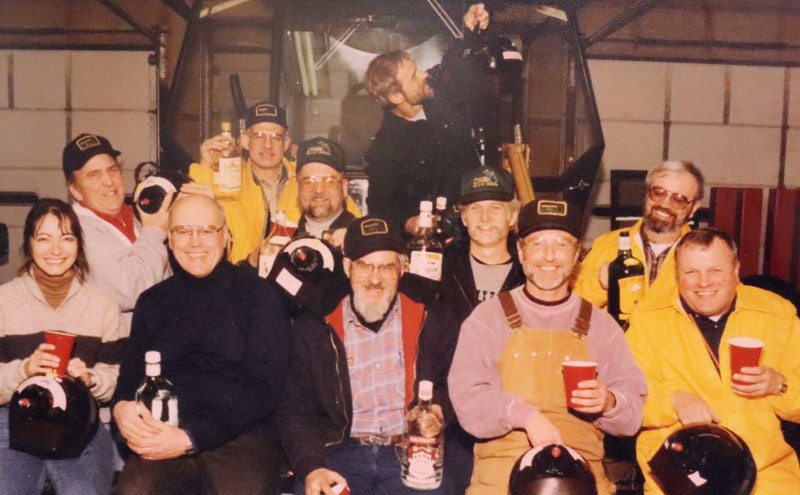Author’s note: My interview with Gary took place in February, prior to his death in May 2021.
ROSCOMMON – Wildlife Biologist Gary Boushelle retired from the Michigan Department of Natural Resources (DNR) in 1998. He reflected on his work over the decades and helping to oversee the state’s elk population and hunts.
“I got involved with all the interesting projects in Michigan,” Gary said. “Worked with bears, deer, ducks. I trapped ducks in Canada, Saskatchewan, It was a cooperative effort there – I represented Michigan. We had people from other states and Federal Fish & Wildlife service.”
Moose and elk projects
“I worked on the elk project. That was an interesting one. Wisconsin wanted elk. They made a deal with our administrators. Their governor, Tommy Thompson, wanted elk there,” Gary explained.
According to the Wisconsin DNR, elk were once widespread across North America. They disappeared in Wisconsin in the 1800s because of hunting and habitat loss. Their reintroduction began in 1989 when they looked at the feasibility of reintroducing elk, moose, and caribou. It was decided that elk could be successfully reintroduced.
“His (Thompson’s) people wanted elk. I was involved in that project there,” Gary recalled. “We trapped up in the Pigeon River country. 25 elk. We quarantined them. Our vets and their vets checked them out because that’s the dairy state you know. We didn’t want any infected animals there.”
“The time came to bring the elk there to Wisconsin. They went to the north end, close to the Michigan border, a place called Clam Lake.
“We put them in a large, fenced in area that they were checked by their vets to make sure they were disease free. It went real well.”
Michigan’s native elk disappeared around 1875. They were reintroduced in 1918.
“Our elk came in 1957,” Gary said. “They were down in Allegan, southwest Michigan. It used to be the Allegan State Forest which became the Allegan Game Area. They were doing well. So we wanted to move them around and expand that population. Eventually they ended up going to the Pigeon. They did very well in the Pigeon.”

First elk hunts
According to the Michigan DNR website, Michigan’s first elk hunts were held in 1964 and 1965 in response to the growing elk population. The hunts “were a success but were not immediately continued.”
Not everything was as “successful” as the DNR made it out to be for those first hunts.
“The first hunt we had 20 hunters,” Gary said. “And a drawing. We had an orientation for them. They all had to come to the orientation that was in Gaylord. Then we had the hunt out of Atlanta.”
“The permits that went out, a lot of politicians got them. There was a lot of select names. That was before my time,” Gary said. “So, the elk hunt was shut down. They weren’t going to bring that up any more. It caused more grief than anything.
Elk hunts started again in the 1980s as a tool to control the elk numbers and distribution. While the herd is concentrated in the Atlanta area, they do migrate south.
When the hunt was reestablished, the DNR held a series of meetings throughout the state to discuss the potential rules and objectives, of the hunt.
Politicians weren’t the only ones wanting preferential treatment at the time.
“Local landowners wanted to have preferential treatment. ‘If I own a farm here, I want to have a permit.’ Well, after we held these meetings, the word got out that this isn’t going to fly. That was good. There wasn’t any preferential treatment,” Gary explained.
“We spent a lot of time at those meetings so that people could understand there’s no select picking of who’s going to get a permit and who isn’t,” he said. “It’s going to be a random choice. And I think that led to the success of us holding that first (reestablished) hunt – it went smooth as could be. Putting the time into it so the public understood what we were doing.”
“There are about 100 hunters now,” Gary said. “Prime elk area is about 200 square miles. But one of the things we needed to do was expand out that area because we didn’t want the herd to spread into the agricultural areas. We wanted to keep them in that state forest area.”
But as wild animals often do, they set their own boundaries.
“They’ve had them as south as Grayling, they’ve wandered down that far.,” Boushelle said. “They just wander out of that elk range. I-75, we had a road kill there just south of Grayling a few years ago. They don’t (range) that far.”
Michigan’s elk hunt continues to this day. Applications can be purchased May 1 to June 1 with drawing results available online July 6. Visit Michigan.gov for more information.


